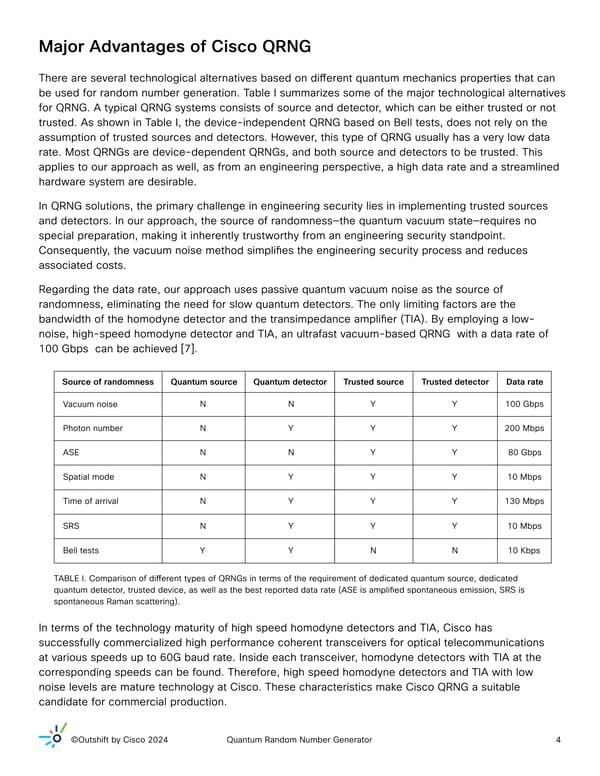Major Advantages of Cisco QRNG There are several technological alternatives based on different quantum mechanics properties that can be used for random number generation. Table I summarizes some of the major technological alternatives for QRNG. A typical QRNG systems consists of source and detector, which can be either trusted or not trusted. As shown in Table I, the device-independent QRNG based on Bell tests, does not rely on the assumption of trusted sources and detectors. However, this type of QRNG usually has a very low data rate. Most QRNGs are device-dependent QRNGs, and both source and detectors to be trusted. This applies to our approach as well, as from an engineering perspective, a high data rate and a streamlined hardware system are desirable. In QRNG solutions, the primary challenge in engineering security lies in implementing trusted sources and detectors. In our approach, the source of randomness—the quantum vacuum state—requires no special preparation, making it inherently trustworthy from an engineering security standpoint. Consequently, the vacuum noise method simplifies the engineering security process and reduces associated costs. Regarding the data rate, our approach uses passive quantum vacuum noise as the source of randomness, eliminating the need for slow quantum detectors. The only limiting factors are the bandwidth of the homodyne detector and the transimpedance amplifier (TIA). By employing a low- noise, high-speed homodyne detector and TIA, an ultrafast vacuum-based QRNG with a data rate of 100 Gbps can be achieved [7]. Source of randomness Quantum source Quantum detector Trusted source Trusted detector Data rate N N Y Y 100 Gbps Vacuum noise Photon number N Y Y Y 200 Mbps ASE N N Y Y 80 Gbps Spatial mode N Y Y Y 10 Mbps Time of arrival N Y Y Y 130 Mbps SRS N Y Y Y 10 Mbps Bell tests Y Y N N 10 Kbps TABLE I. Comparison of different types of QRNGs in terms of the requirement of dedicated quantum source, dedicated quantum detector, trusted device, as well as the best reported data rate (ASE is amplified spontaneous emission, SRS is spontaneous Raman scattering). In terms of the technology maturity of high speed homodyne detectors and TIA, Cisco has successfully commercialized high performance coherent transceivers for optical telecommunications at various speeds up to 60G baud rate. Inside each transceiver, homodyne detectors with TIA at the corresponding speeds can be found. Therefore, high speed homodyne detectors and TIA with low noise levels are mature technology at Cisco. These characteristics make Cisco QRNG a suitable candidate for commercial production. ©Outshift by Cisco 2024 Quantum Random Number Generator 4
 Quantum Random Number Generator Page 3 Page 5
Quantum Random Number Generator Page 3 Page 5